Pilgrims study refugees, resettlement process in Rwanda, KenyaPosted Apr 8, 2015 |
|
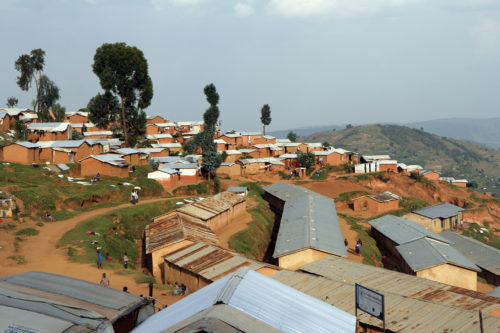
Gihembe Refugee Camp is home to 14,500 Congolese refugees who’ve sought shelter in Rwanda. Photo: Lynette Wilson/ENS
[Episcopal News Service] A little more than an hour’s drive outside Rwanda’s capital Kigali, 14,500 Congolese refugees live atop and along a hillside in red mud huts safely nestled in the country’s interior, far from the Democratic Republic of Congo’s North Kivu province from which most of them fled armed conflict and violence in the mid-1990s.
Gihembe Refugee Camp was established in 1997 after armed militias massacred Congolese refugees receiving shelter in a refugee camp in northwest Rwanda. Many residents have spent nearly two decades in Gihembe, one of five refugee camps in Rwanda serving 74,000 refugees, more than half younger than 18.
Since 1998, more than 5.5 million people have died in Congo from fighting, disease and malnutrition; 2.5 million people have been internally displaced; and some 500,000 have fled the country’s lengthy conflict, with the vast majority living in refugee camps in the Great Lakes and Horn of Africa regions. Congolese refugees form the sixth-largest refugee population in the world and 18 percent of the total refugee population in Africa.
Of the more than 500,000 Congolese refugees in the region, an estimated 160,000 are eligible for resettlement, according to the United Nations High Commissioner for Refugees (UNHCR).
Given the numbers, the protracted nature of the conflict and no sign of peace, in recent years UNHCR and its partners prioritized the resettlement of Congolese refugees. The goal is to resettle 50,000 people by 2017 – with 80 percent destined to come to the United States.

Paul Kenya, a resettlement officer for UNHCR in Rwanda, Deborah Stein, director of Episcopal Migration Ministries, and #ShareTheJourney pilgrims listen as Dr. Pascal Kalinda Murego talks about the health of refugees and the health services provided in Gihembe camp. Photo: Lynette Wilson/ENS
In early March, eight Episcopalians participated in a #ShareTheJourney pilgrimage, led by the Episcopal Church, to Africa’s Great Lakes region and visited Gihembe to learn about the plight of Congolese refugees and the United States Refugee Admissions Program.
“The purpose,” said Deborah Stein, director of Episcopal Migration Ministries, was “to show The Episcopal Church, through the lens of Congolese refugees bound for resettlement, how resettlement works from the beginning to arrival in the U.S.”
It was also an opportunity to inspire the pilgrims to become advocates for refugees, added Stein.
The March 2-13 pilgrimage included stops in Kenya and Rwanda, where, besides visiting the camp, the pilgrims met with representatives and resettlement officers working for UNHCR, the International Organization for Migration, Church World Service’s Africa Resettlement Support Center and other overseas refugee-service providers and resettlement partners.
Through Episcopal Migration Ministries, the Episcopal Church partners with 30 resettlement affiliates in 26 dioceses nationwide. It is one of nine agencies – six of them faith-based – working in partnership with the U.S. Department of State to welcome and resettle refugees to the United States.
The Episcopal Church’s involvement in refugee resettlement dates back at least to World War II, when churches sponsored refugees who fled Nazi oppression. Beginning with the Presiding Bishop’s Fund for World Relief (now Episcopal Relief & Development) and later partnering with Church World Service, the Episcopal Church established Episcopal Migration Ministries in 1988.
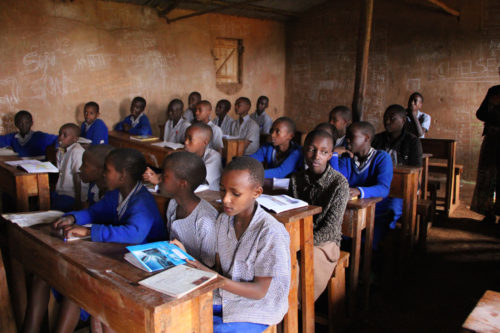
Primary school students study in a classroom in Gihembe camp. More than half of the camp’s 14,500 residents are under the age of 18. Photo: Wendy Johnson/EMM
A refugee is someone who has fled his or her country of nationality because of a “well-founded fear of persecution” based on race, religion, ethnicity or political or social affiliation. It is an internationally recognized and legally protected status.
The United States formalized its refugee-resettlement program with the Refugee Act of 1980 in response to the increased numbers of refugees fleeing communism in Southeast Asia. Until then, churches sponsored refugees’ visas; but by the mid-1970s, that process was insufficient to meet the need, explained Stein.
Today, there are 15.5 million refugees worldwide. UNHCR’s mandate is to provide international protection for refugees.
UNHCR’s primary focus is on repatriation, or safe return home, followed by citizenship or legal residency in the host country. The third option is resettlement to one of the 20-plus countries worldwide that accepts refugees. Globally, less than 1 percent of refugees receive resettlement, with 75 percent destined for the United States.
“The success of resettlement programs depends on partnership and coordination. We must have resettlement countries willing to receive refugees,” said Paul Kenya, a resettlement officer working for UNHCR in Rwanda, in an interview with Episcopal News Service in Kigali. “You must also have partners to work with UNHCR to identify refugees and help in the processing of interviewing, coordinating medical examinations and travel logistics. Even the government of Rwanda helps us in verifying refugee status and giving exit visas to leave the country.”
Through surveys, most Congolese refugees say they are unwilling to return to their home country because of the conflict there and because they cannot regain their land if they return, he said.
“Resettlement, then, becomes the only viable solution for most of these refugees,” said Kenya, adding that last year, 2,000 Congolese refugees were resettled to the United States from camps in Rwanda. We hope to continue the partnership coming up with another multi-year strategy to cover the next three or four years, with an average of at least 3,000 refugees each year.”
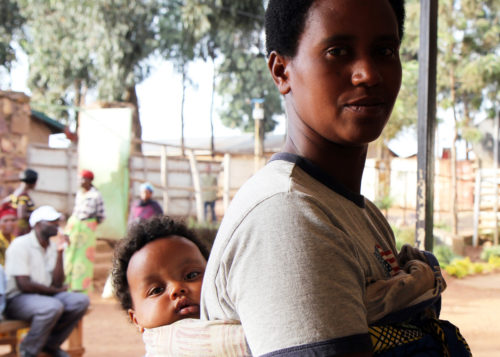
A mother and child pose for a photo in Gihembe camp. The majority of the camp’s households are headed by single women. Photo: Lynette Wilson/ENS
Once identified for resettlement, either by UNHCR, a host government, or another partner, a refugee or refugee family’s case is forwarded to the Church World Service’s Africa Resettlement Support Center, which covers 49 sub-Saharan countries and helps the U.S. Department of State’s Bureau of Population, Refugees and Migration to process refugees for possible admission to the United States.
Families are processed as a case, with five members being the average family size. Many Congolese refugee families are headed by women, the majority of them survivors of trauma and sexual- and gender-based violence.
As the pilgrims learned through meetings with senior staff members at the resettlement support center’s Nairobi headquarters, the process, which includes extensive background checks, takes an average two years and is subject to delay by any change in the family, such as a marriage or a birth. The U.S. Citizen and Immigration Services, a division of the Department of Homeland Security, makes the final determination on cases bound for the United States.
“We prepare the best case for referral so that they can make it through the process,” said Miro Marinovich, the support center’s director.
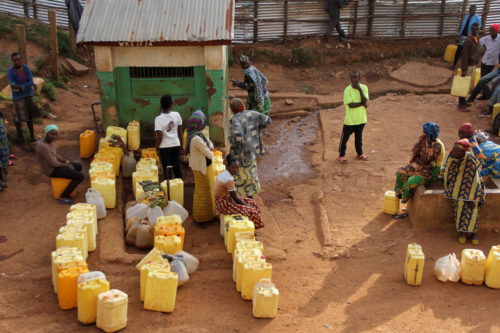
Residents of Gihembe camp congregate around the water tap to fill their jugs. Water shortages are common in the camp. Photo: Wendy Johnson/EMM
The refugees have lived with food and water shortages, limited opportunities for education and work, Marinovich added. “We want to ensure that that never happens to them again.”
Of the 74,000 refugees in Rwanda, 99 percent are Congolese, and the majority are women and children. UNHCR began working with resettlement countries on a multi-year strategy to resettle Congolese refugees in 2012, identifying 10,000 refugees in camps in Rwanda for resettlement.
Once a case is approved for resettlement, the pace picks up considerably. The International Organization for Migration, or IOM, which handles medical examinations and travel, kicks into gear, transporting the refugees to a regional transport center, where they’ll stay for two weeks pending final medical and security checks. During that time, cultural orientation classes begin.
When the pilgrims visited a transit center in Nairobi, children played outside on plastic playground equipment while adults in the classroom learned about finances and budgeting. Besides rooms devoted to life in Canada, Australia and the United States (which has two rooms), a model kitchen and bathroom acquaint refugees with modern amenities.
A scale to weigh departing passengers’ luggage sits under a metal awning, plastic chairs off to the side. An airplane seat familiarizes refugees with air travel. A travel wardrobe – for men a tracksuit and sneakers, for women more traditional clothing – is available for those in need of travel attire.
Connecting with overseas resettlement partners gave the pilgrims a better understanding of the process and allowed Episcopal Migration Ministries’ staff to share information about what happens to refugees when they arrive in the United States.
“Most often the people who are involved in the processing on the overseas-side have no idea what is happening once a refugee gets on a plane and comes to the United States,” Stein said. “So, as much as we were able to learn from our colleagues at UNHCR, IOM and the refugee-resettlement support center, we were also able to share information with them about what happens to refugees when they get to the United States.”
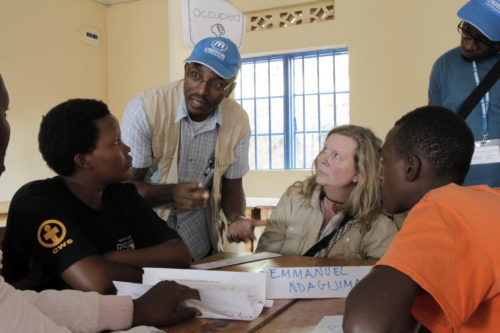
Paul Kenya, a resettlement officer working for the United Nations High Commissioner for Refugees in Rwanda, and Jessica Benson of the Diocese of Idaho, talk with students in an ESL class in Gihembe camp. Photo: Lynette Wilson/ENS
During a town hall meeting at Gihembe camp, refugees, many of them frustrated by years of living in the camp, were desperate for information about their individual cases and what could be done to move them along. Despite being told that the pilgrims couldn’t answer questions about the process, but rather offer them information on life in the United States, they saw an opportunity to ask about their individual cases.
The Democratic Republic of Congo is Africa’s second-largest country geographically and fourth-largest by population, with more than 80 million people. In terms of natural resources, including copper, silver, gold, diamonds, uranium and other minerals, it’s one of the richest countries in the world.
As neighbors, Congo and Rwanda long have been connected, and at times at war.
In the 1870s, King Leopold II of Belgium carved out a section of Central African rainforest and made it his private colony, calling it the “Congo Free State.” In reality, it wasn’t “free.” Leopold created a forced labor camp to harvest wild rubber. Killings and atrocities were committed on a massive scale. In 1908, in response to protests over such violence, Congo fell under the Belgian state.
In the late 1930s, the Belgians recruited tens of thousands of Rwandans to work their cattle ranches and plantations in North Kivu. Unrest in Rwanda following its independence from Belgium in 1962 drove another 100,000 Rwandans over the border into Congo. In 1971, the Congolese government granted citizenship to all Rwandans who’d been in the country since 1960; that citizenship later was revoked.
During Rwanda’s civil war in the early 1990s and the 1994 genocide, during which an estimated 800,000 to 1 million people were massacred within 100 days, Rwandans continued to flee into neighboring countries, including Congo. Congolese refugees fled violence in eastern Congo in waves, beginning in 1995, with the most recent wave starting in 2012.
About a tenth the size of the Congo, Rwanda is about the size of Massachusetts. With a population of 11.7 million, it is the most densely populated country in Africa. Rwandans continue to be displaced in Uganda, Tanzania and the Congo more than 20 years after the genocide.
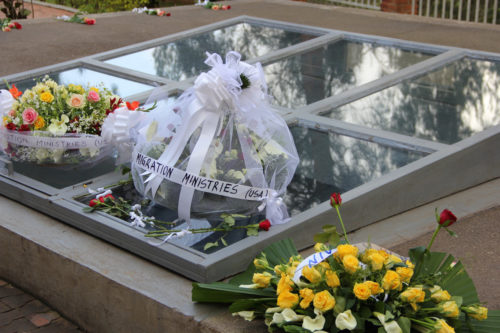
#ShareTheJourney pilgrims laid flowers during a visit to the Kigali Genocide Memorial in Rwanda. An estimated 800,000 to 1 million people were killed during the Rwandan Genocide in 1994. Photo: Wendy Johnson/EMM
“Rwanda is expecting over 100,000 Rwandans to return – so there really is no prospect for integration for the [Congolese] refugees, and resettlement becomes the only option for them,” said Kenya.
Resettlement is one way the international community can help alleviate the burden from countries in the region that host refugees.
Before the terrorist attacks of 9/11, the United States resettled roughly 80,000 refugees annually, and upwards of 120,000 at the height of Southeast Asian resettlement in the early 1980s. After 9/11, the number decreased to 32,000. More than a decade later, the 2015 quota is set at 70,000.
The resettlement figure is important, say officials, because it sends a message of willingness to other resettlement countries, and it alleviates a fraction of the host country’s burden.
Unlike the torture and killing in Darfur, Sudan and South Sudan, and the large numbers of Somalis fleeing terrorism in Somalia, Congo’s brutal conflict hasn’t received the same level of attention.
There are 2.7 million refugees and asylum seekers across East Africa, the Horn of Africa and the Great Lakes region. Ethiopia and Kenya host the majority of people fleeing violence and political instability in Somalia, South Sudan, Sudan, Eritrea and Congo. Somalis make up the largest refugee group in the region, numbering more than 970,000 registered refugees.
Two new camps opened in Rwanda in 2012, the last time the conflict in eastern Congo escalated. Even without a steady flow of refugees, the camps have a 3 percent annual population growth as babies are born in the camp.
“The Rwanda government is overburdened with the refugees, yet it is still opening its borders,” Kenya said. “In the last two years, the camp population has doubled, so resettlement provides hope for the refugees, it provides a tool to share responsibility with the countries, and it gives UNHCR a durable solution.
“We ask resettlement countries to increase their spaces because the situation on the ground shows the resettlement needs are there.”
Unlike other regional countries that host refugees – Ethiopia and Kenya being the largest – Rwanda doesn’t have a forced-encampment policy, explained Kenya. UNHCR has started a program alternative to camps, integrating its education and health services with the Rwandan government.
“If the refugees ever go back to the [Democratic Republic of Congo] or there’s another solution, then at least they build their skills and their lives are almost managed at a normal level,” said Kenya. “But with the DRC situation, we don’t see the possibility of return.”
— Lynette Wilson is an editor and reporter for the Episcopal News Service.

Social Menu